Ames W.F., Roger C. Nonlinear equations in the applied sciences. Volume 185
Подождите немного. Документ загружается.

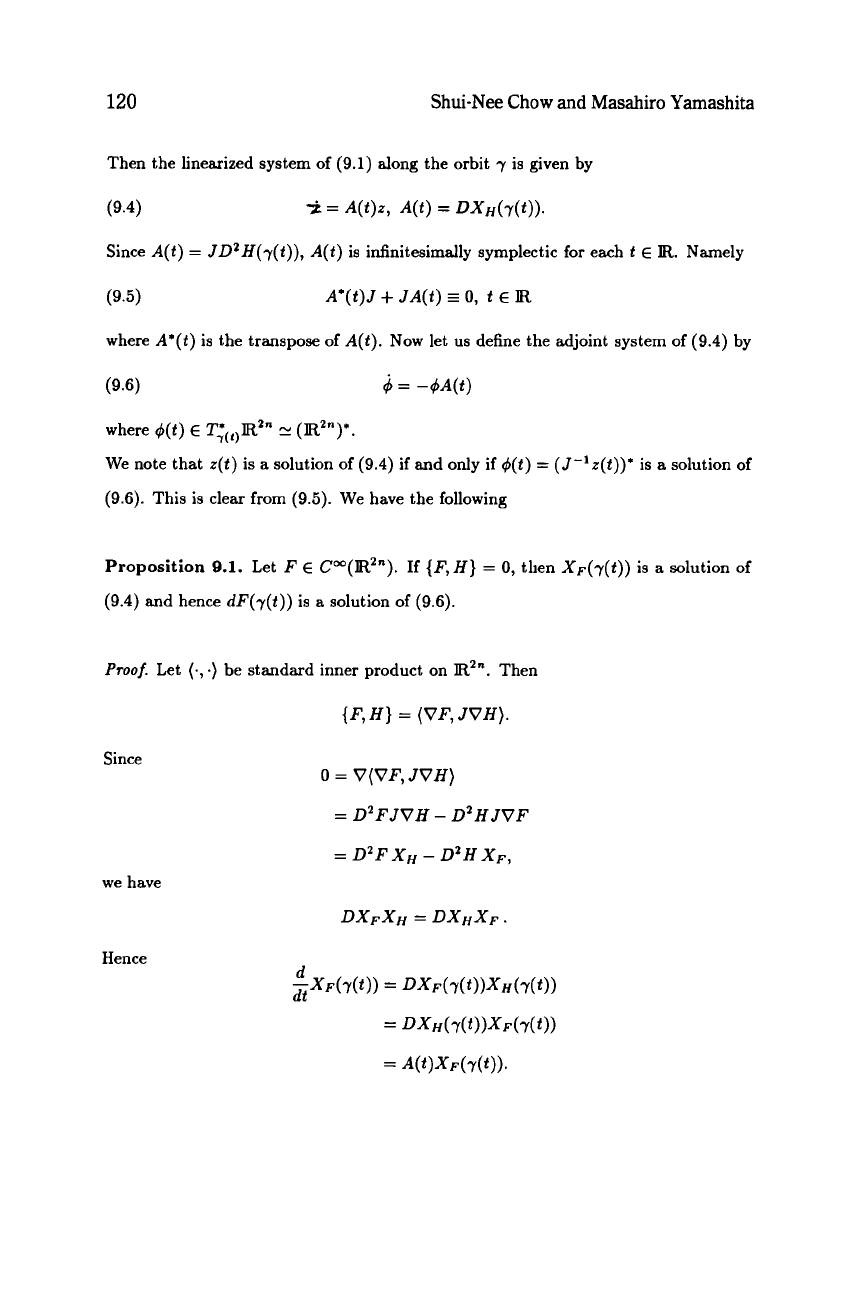
120
Shui-Nee Chow
and
Masahiro Yamashita
Then the linearized system
of
(9.1) along the orbit
y
is
given by
(9.4)
i
=
A(t)z, A(t)
=
Dx~(y(t)).
Since
A(t)
=
JDZH(y(t)), A(t)
is infinitesimally symplectic for each
t
E
IR.
Namely
(9.5)
A*(t)J
+
JA(t)
=
0,
t
E
R
where
A*(t)
is
the transpose
of
A(t).
Now
let
us
define the adjoint system of (9.4) by
(9.6)
4
=
-c$A(t)
where
d(t)
E
T~~t~R2"
N
(RZn)*.
We note that
~(t)
is
a
solution of (9.4) if and only if
c$(t)
=
(J-'z(t))*
is
a
solution of
(9.6). This is clear from (9.5). We have the following
Proposition
0.1.
Let
F
E
Cm(R2").
If
{F,
H}
=
0,
then
XF(Y(~))
is
a
solution of
(9.4) and hence
dF(y(t))
is
a
solution of (9.6).
Proof.
Let
(.,
.)
be standard inner product on
RZ".
Then
{F, H}
=
(VF, JVH).
Since
0
=
V(VF, JVH)
=
D~FJVH
-
D~HJVF
=
D~FX~
-
D~HX~,
we have
Hence
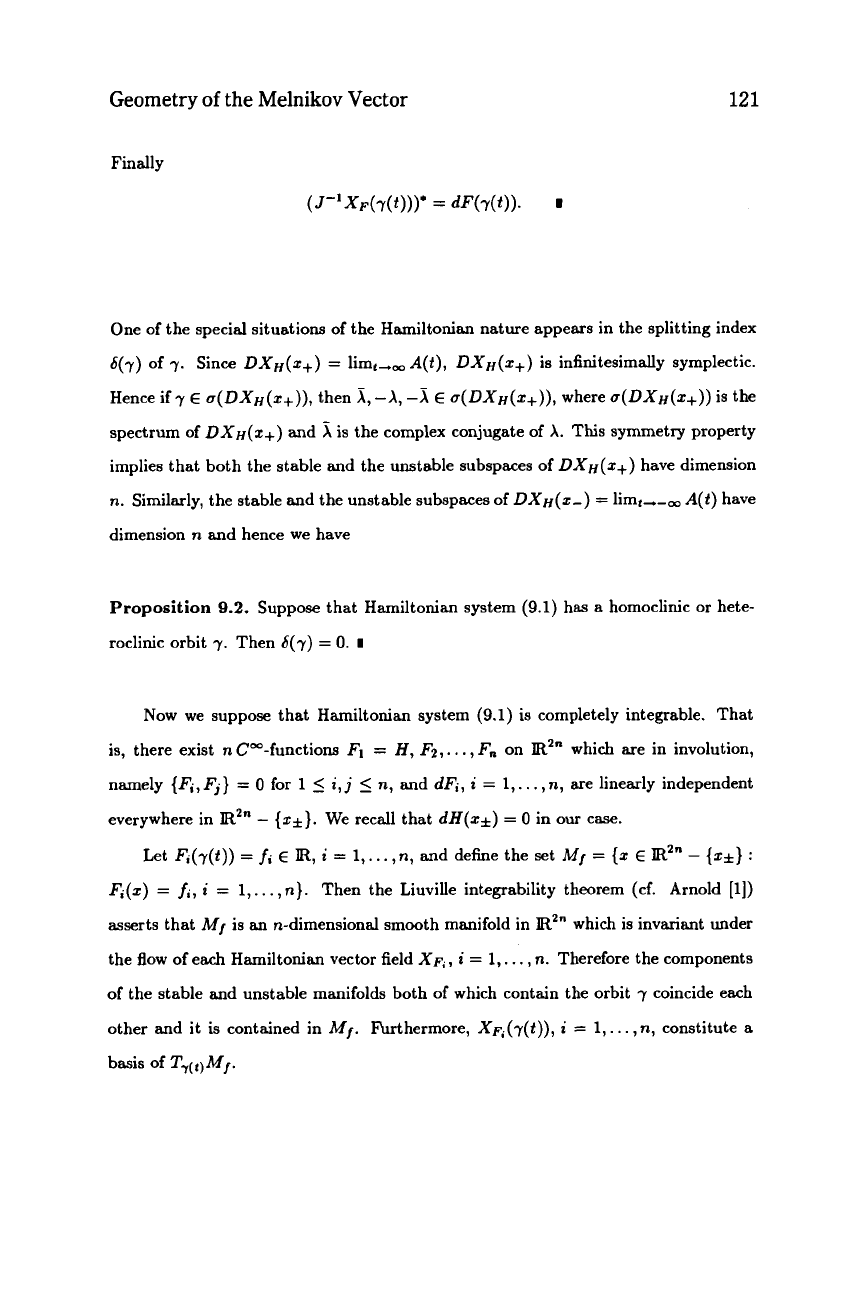
Geometry
of
the Melnikov Vector
Finally
121
One
of
the special situations of the Hamiltonian nature appears in the splitting index
6(7)
of
7.
Since
DXjq(z+)
=
limt-oo
A(t),
DXjq(z+)
is infinitesimally symplectic.
Hence if
7
E
u(DX,(z+)),
then
x,
-A,
-x
E
u(DXjq(z+)),
where
u(DXjq(z+))
is the
spectrum
of
DXH(Z+)
and
5
is the complex conjugate
of
A.
This symmetry property
implies that both the stable and the unstable subspaces of
DX,(z+)
have dimension
n. Similarly, the stable and the unstable subspaces of
DXjq(z-)
=
limt,-,
A(t)
have
dimension n and hence we have
Proposition
9.2.
Suppose that Hamiltonian system
(9.1)
has
a
homoclinic or hete-
roclinic orbit
7.
Then
6(7)
=
0.
I
Now we suppose that Hamiltonian system
(9.1)
is
completely integrable. That
is, there exist n Coo-functions
Fl
=
H,
Fz,
. . .
,
F,,
on
IR'"
which are in involution,
namely
{F,,
Fj}
=
0
for
1
5
i,
j
5
n, and
dFi,
i
=
1,.
. .
,
n, are linearly independent
everywhere in
Elz"
-
{z*}.
We recall that
dH(z*)
=
0
in our
case.
Let
F,(-y(t))
=
f,
E
IR,
i
=
1,.
. .
,n, and defme the set
Mf
=
{z
E
IR'"
-
{z*}
:
F,(z)
=
f,,
i
=
1,.
. .
,n}. Then the Liuville integrability theorem (cf. Arnold
[l])
asserts that
Mf
is an n-dimensional smooth manifold in
R'"
which is invariant under
the flow
of
each Hamiltonian vector field
Xpi
,
i
=
1,.
.
.
,
n. Therefore the components
of the stable and unstable manifolds both of which contain the orbit
7
coincide each
other and it is contained in
Mf.
Furthermore,
Xpi(7(t)),
i
=
1,.
.
.
,
n, constitute
a
basis of
T,(t)Mf.
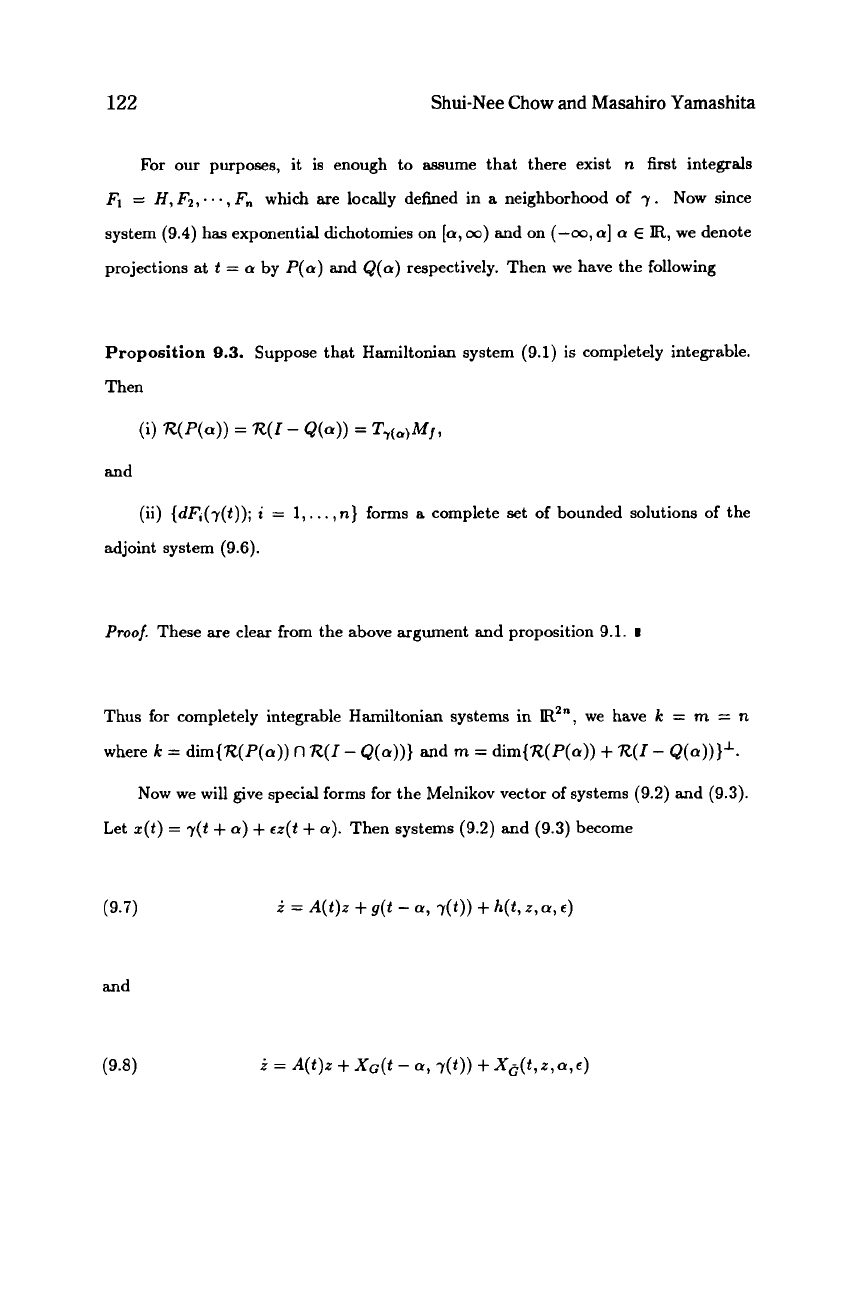
122
Shui-Nee
Chow
and
Masahiro Yamashita
For
our
purposes, it is enough to assume that there exist
n
first integrals
FI
=
H,
F2,.
. .
,
F,
which
are
locally defined in
a
neighborhood of
7.
Now since
system (9.4) has exponential dichotomies on
[a,
OD)
and on
(-m,
a] a
E
R,
we denote
projections at
t
=
a
by
P(a)
and
&(a)
respectively. Then we have the following
Proposition
9.3.
Suppose that Hamiltonian system (9.1) is completely integrable.
Then
(i)
R(P(a))
=
R(I-
&(a))
=
T-,(a)Mj,
and
(ii)
{dF,(y(t));
i
=
1,.
. .
,n}
forms
a
complete set of bounded solutions of the
adjoint system (9.6).
Proof.
These
are
clear from the above argument and proposition 9.1.
I
Thus for completely integrable Hamiltonian systems in
R2",
we have
k
=
rn
=
n
where
k
=
dirn{R(P(a))
n
R(I
-
Q(a)))
and
m
=
dim{R(P(a))
+
R(I
-
&(a))}*.
Now we will give special forms for the Melnikov vector of systems (9.2) and (9.3).
Let
z(t)
=
~(t
+
a)
+
cz(t
+
a).
Then systems (9.2) and (9.3) become
and
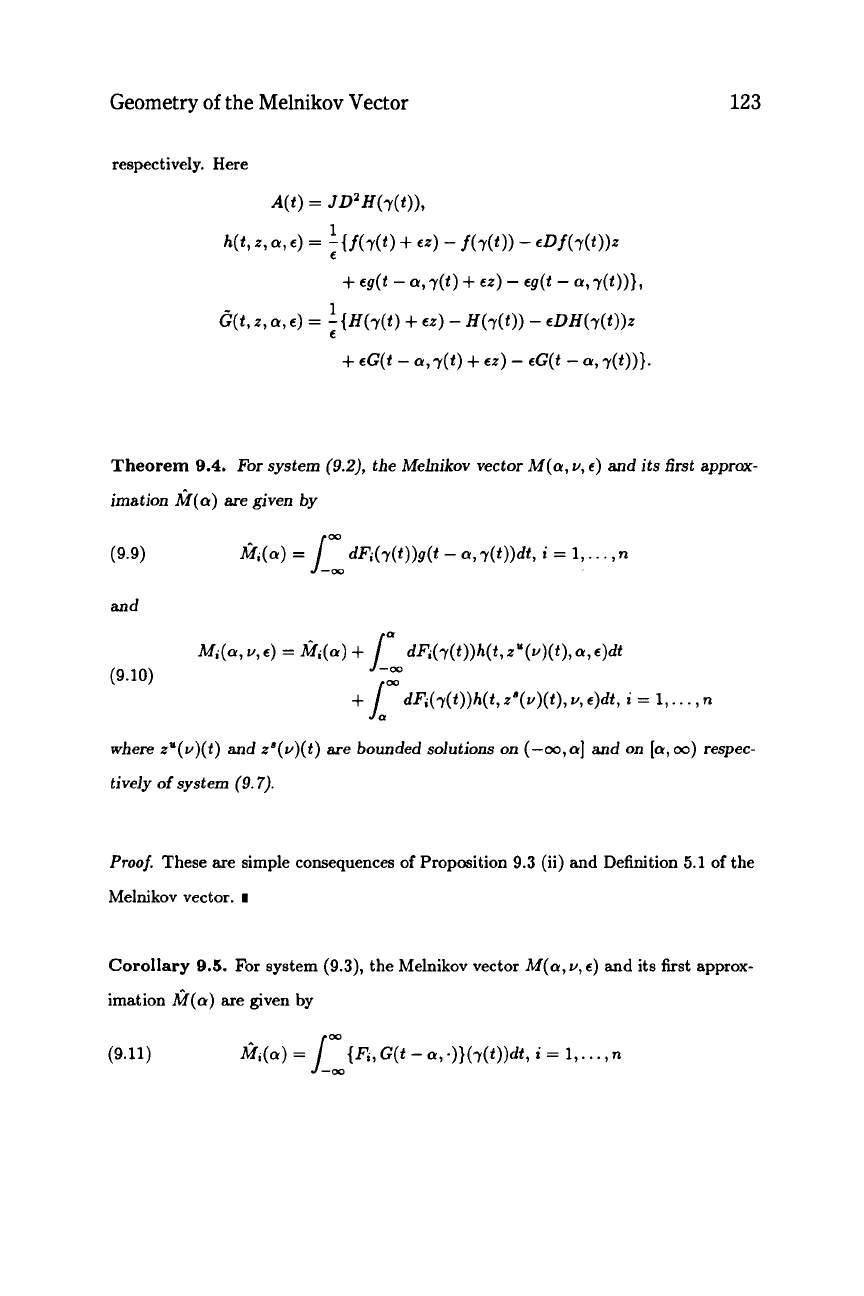
Geometry
of
the Melnikov Vector
123
Theorem
9.4.
For
system
(9.2),
the Melnikov vector
M(a,
u,
e)
and its
first
approx-
imation
M(
a)
are
given by
00
(9.9)
Mi(.)
=
lm
dFi(-y(t))g(t
-
a,y(t))dt,
i
=
1,.
. .
,n
and
dF1(r(t))h(t,z"(u)(t),
u,
e)dt,
i
=
1,.
. .
,n
where
z"(u)(t)
and
z"(u)(t)
are
bounded solutions on
(-w,a]
and on
[a,
w)
respec-
tively
of
system
(9.7).
Proof.
These are simple consequences
of
Proposition 9.3 (ii) and Definition 5.1
of
the
Melnikov vector.
I
Corollary
9.5.
For system (9.3), the Melnikov vector M(a,
u,
e)
and its first approx-
imation
M(a)
are given by
00
(9.11)
&,(a)
=
[
{Fi,
G(t
-
a,
.)}(y(t))dt,
i
=
1,.
. .
,n
J
-00
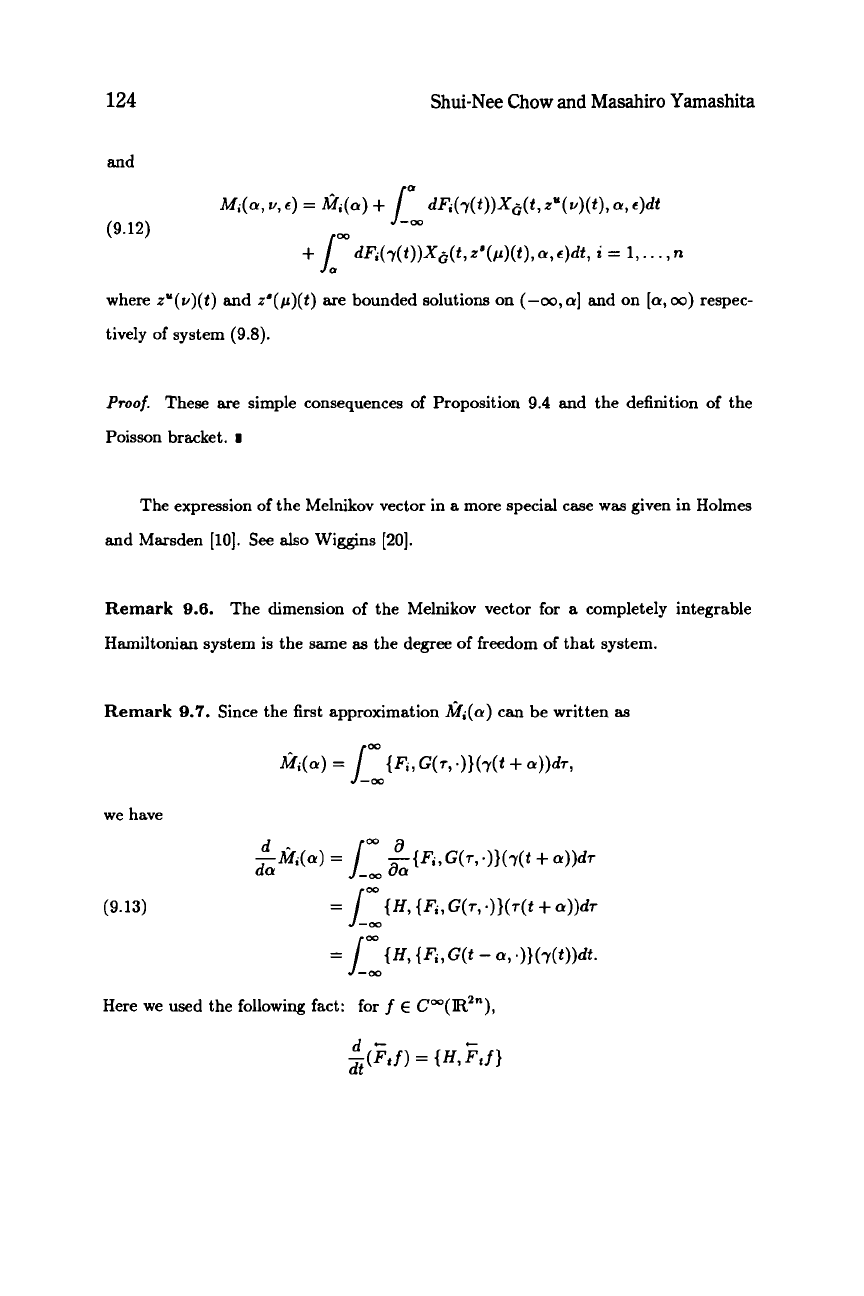
124
Shui-Nee Chow
and
Masahiro Yamashita
and
Mi(a,
V,
c)
=
Gi(0)
+
dFi(r(t))xe(tv
z"(v)(t),
a,
e)dt
(9.12)
.L
+
lw
dF,(r(t))Xg(t,z'(tc)(t),a,e)dt,
i
=
1,.
. .
,n
where
z"(v)(t)
and
.z'(p)(t)
are bounded solutions on
(--oo,a]
and on
[a,=)
respec-
tively of system (9.8).
Proof.
These
are
simple consequences of Proposition 9.4 and the definition
of
the
Poisson bracket.
a
The expression
of
the Melnikov vector in
a
more special case
was
given in Holmes
and Marsden
[lo].
See
also
Wiggins
[ZO].
Remark
9.6.
Hamiltonian system
is
the same
as
the degree of freedom
of
that system.
The dimension of the Melnikov vector for
a
completely integrable
Remark
9.7.
Since the first approximation
&fi(a)
can be written
as
m
n;l,(a)
=
Im{f'i,
G(r,.)}(~(t
+
a))dr,
we have
(9.13)
Here we used the following fact: for
f
E
Cm(RZ"),
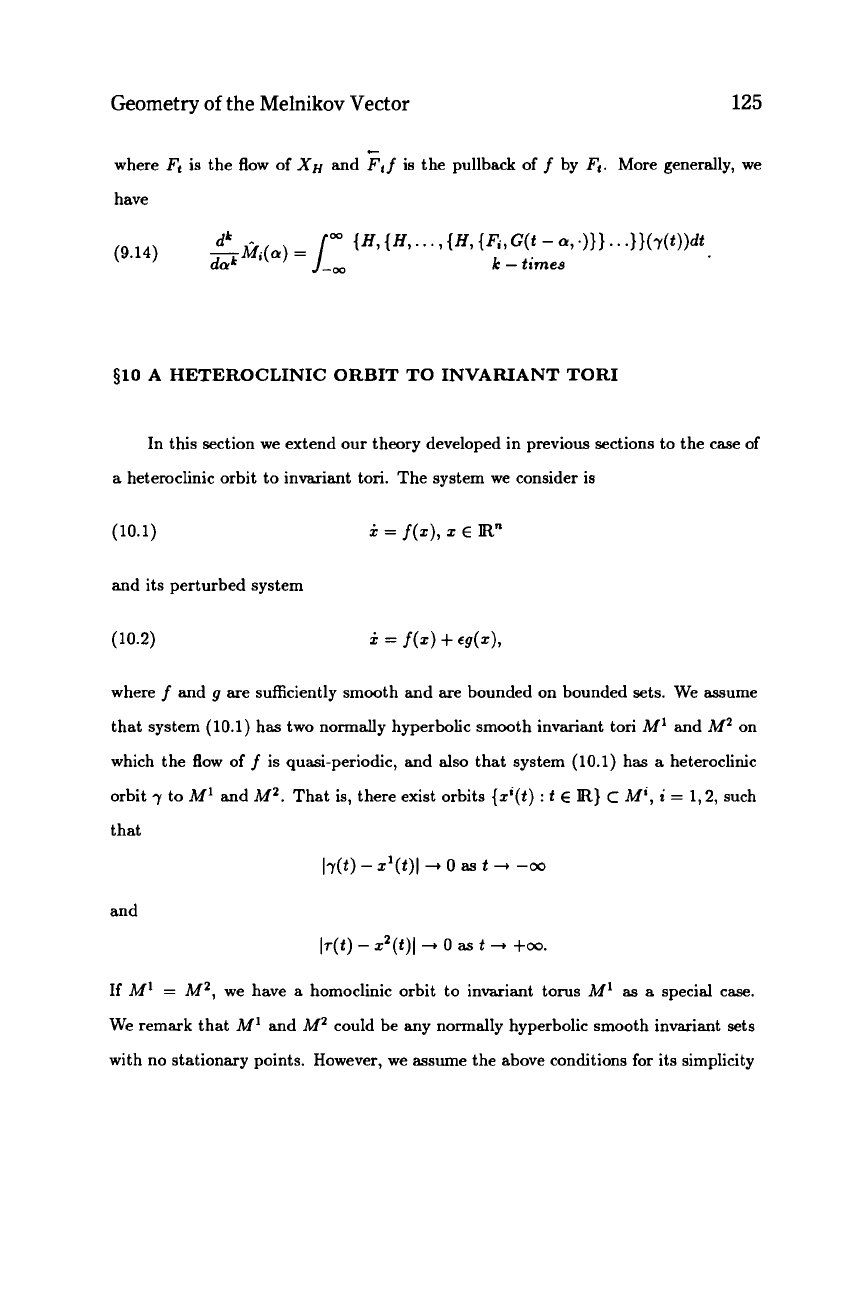
Geometry
of
the Melnikov Vector
125
c
where
Ft
is the flow
of
XH
and
Flf
is the pullback
of
f
by
Fl.
More generally, we
have
$10
A HETEROCLINIC ORBIT TO INVARIANT TORI
In this section we extend our theory developed in previous sections to the case of
a
heteroclinic orbit to invariant ton. The system we consider
is
(10.1)
i
=
f(z),
z
E
R"
and its perturbed system
where
f
and
g
are sufficiently smooth and are bounded on bounded sets. We assume
that system
(10.1)
has two normally hyperbolic smooth invariant tori
M'
and
M2
on
which the flow
off
is quasi-periodic, and also that system
(10.1)
has a heteroclinic
orbit
7
to
M'
and
M2.
That is, there exist orbits
{zi(t)
:
t
E
R}
c
Mi,
i
=
1,2,
such
that
IT(t)
-
51(t)J
+
0
as
t
+
-00
and
17(t)
-
z*(t)l
--t
0
as
t
--t
+oo.
If
M'
=
M2,
we have
a
homoclinic orbit to invariant torus
M'
as
a
special
case.
We remark that
M'
and
MZ
could be any normally hyperbolic smooth invariant sets
with no stationary points. However, we assume the above conditions for its simplicity
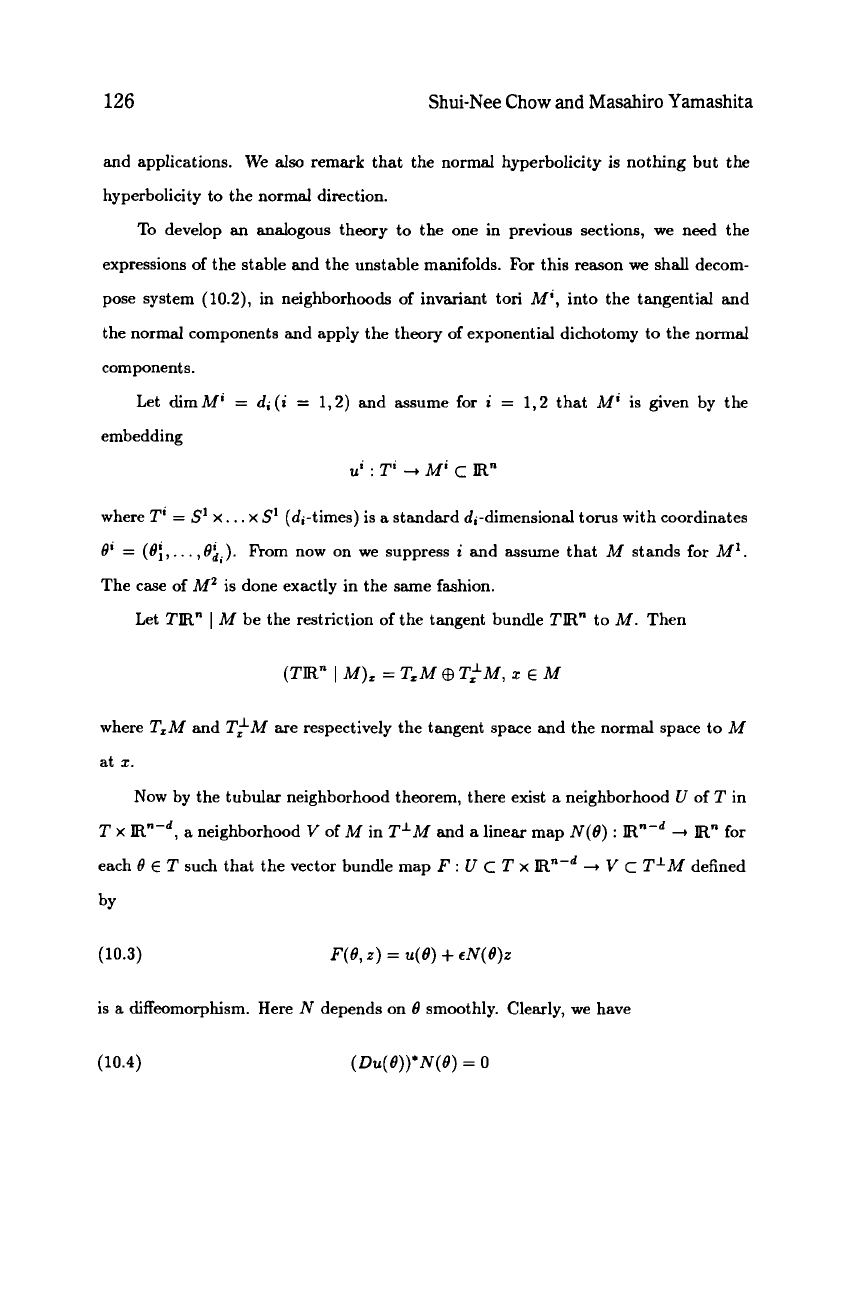
126
Shui-Nee
Chow
and
Masahiro Yamashita
and applications.
We also remark that the normal hyperbolicity
is
nothing but the
hyperbolicity to the normal direction.
To develop an analogous theory to the one in previous sections, we need the
expressions of the stable and the unstable manifolds.
For
this reason we shall decom-
pose system (10.2), in neighborhoods of invariant ton
Mi,
into the tangential and
the normal components and apply the theory of exponential dichotomy to the normal
components
.
Let
dimM'
=
d,(i
=
1,2) and assume for
i
=
1,2 that
Mi
is given by the
embedding
ui
:
Ti
+
Mi
c
R"
where
Ti
=
S'
x..
.
x
S'
(×) is a standard +dimensional torus with coordinates
0'
=
(O:,..
.,t$,).
From now on we suppress
i
and assume that
M
stands for
M'.
The case of
MZ
is done exactly in the same fashion.
Let
TR"
I
M
be the restriction of the tangent bundle
TR"
to
M.
Then
(TR"
I
M),
=
T,M
@
T:M,
z
E
M
where
T,M
and
TkM
are respectively the tangent space and the normal space to
M
at
x.
Now by the tubular neighborhood theorem, there exist a neighborhood
U
of
T
in
T
x
Rn-d,
a neighborhood
V
of
M
in
TIM
and a linear map
N(0)
:
R"-d
+
R"
for
each
0
E
T
such that the vector bundle map
F
:
U
C
T
x
R"-d
+
V
c
TIM
defined
by
is a diffeomorphism. Here
N
depends on
0
smoothly. Clearly, we have
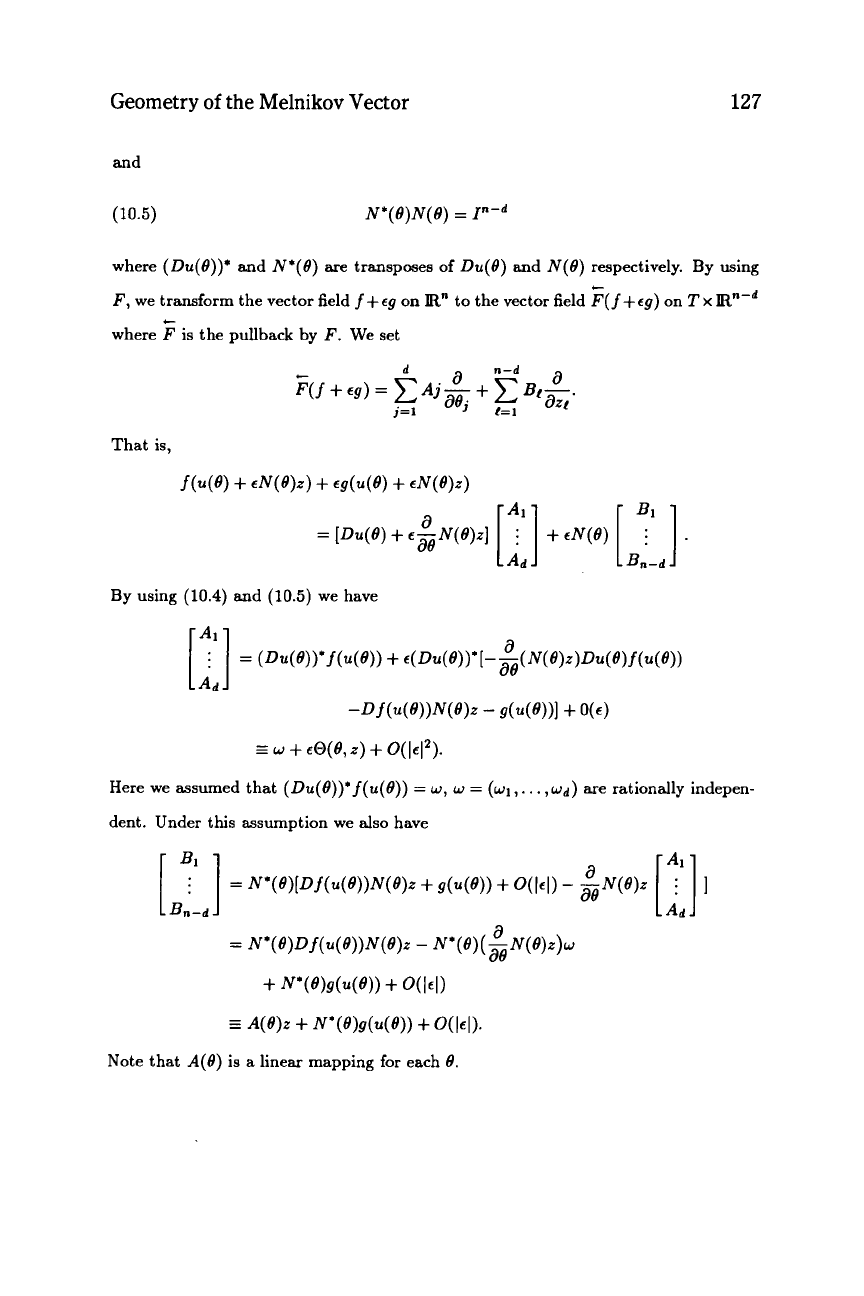
Geometry
of
the Melnikov Vector
127
and
(10.5)
N*(e)N(e)
=I"-~
where
(Du(e))*
and
"(0)
are
transposes
of
h(e)
and
N(0)
respectively. By using
F,
we transform the vector field
f+eg
on
R"
to the vector field
F(f+eg)
on
T
x
Rn-d
where
F
is the pullback by
F.
We set
c
c
By using (10.4) and (10.5) we have
Bn-d
=
+
eo(e,z)
+
o(lel*).
Here we assumed that
(Du(e))*f(u(e))
=
w,
w
=
(wl,.
.
.
,wd)
are rationally indepen-
dent. Under this assumption we also have
Note that
A(0)
is
a
linear mapping
for
each
8.
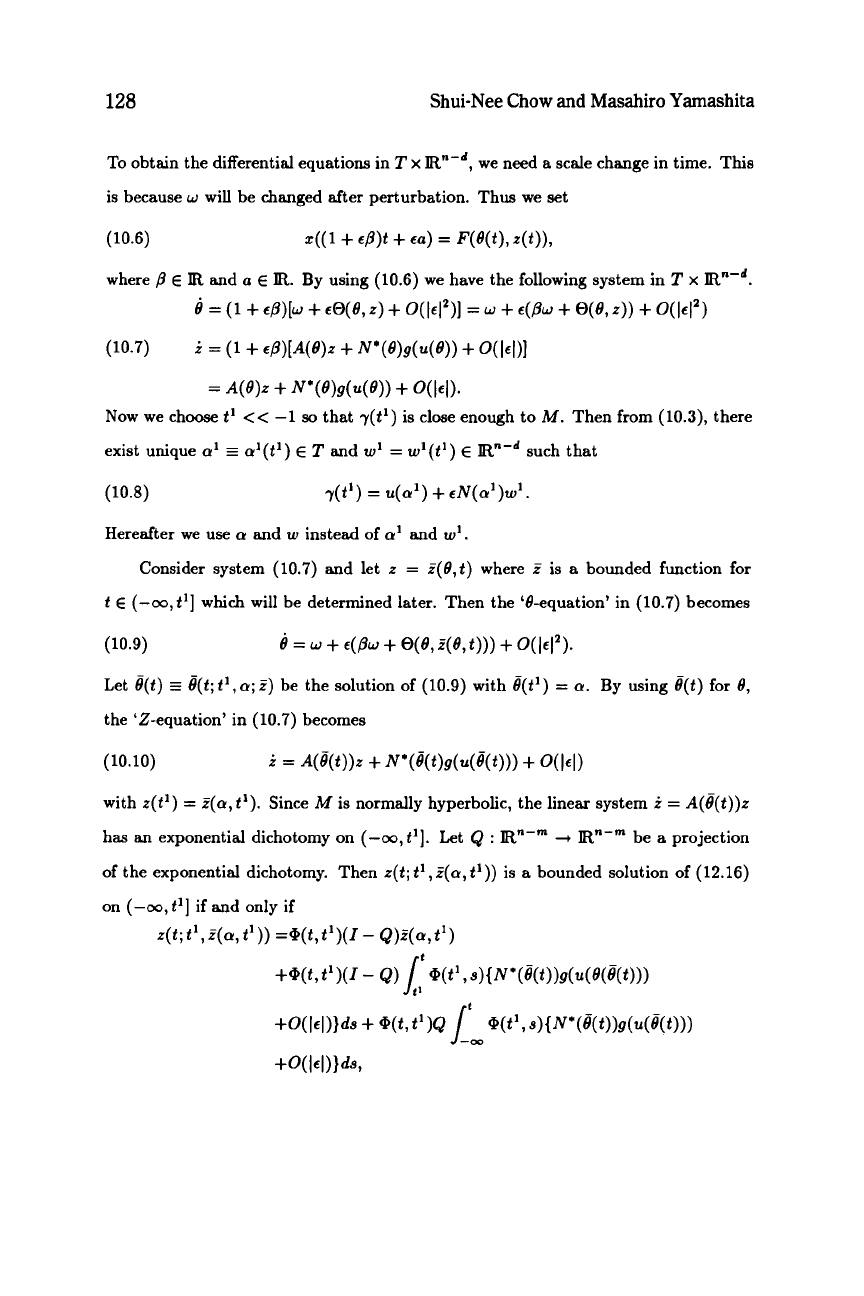
128
Shui-Nee
Chow
and
Masahiro Yamashita
To
obtain the differential equations in
T
x
Rn-d,
we need a scale change in time.
This
is because
w
will be changed after perturbation. Thus we set
(10.6)
z((1
+
Cp)t
+
C.)
=
F(8(t),
Z(t)),
where
/3
E
R
and
a
E
R.
By using (10.6) we have the following system in
T
x
R"-d.
e
=
(1
+
€p)lw
+
Co(8,
.)
+
o(lel*)]
=
o
+
~(PW
+
e(e,
2))
+
o(1~1~)
(10.7)
i
=
(1
+
@)[A(B)z
+
N*(@)g(u(e))
+
O(lcl)]
=
A(~)Z
+
N*(e)g(u(e))
+
o(lCi).
Now
we choose
t'
<<
-1
90
that
~(t')
is
close enough to
M.
Then from (10.3), there
exist unique
a'
=
a'(t')
E
T
and
w'
=
w'(t')
E
R"-d
such that
(10.8)
T(t')
=
.(a')
+
eN(a')w'.
Hereafter we use
Q
and
w
instead
of
a'
and
w'.
Consider system (10.7) and let
z
=
r(8,t)
where
2
is
a
bounded function for
t
E
(-OO,tl]
which will be determined later. Then the '&equation' in (10.7) becomes
(10.9)
8
=
w
+
e(pw
+
o(e,
r(e,t)))
+
o(i#).
Let
e(t)
=
#(t;t',a;f)
be the solution of (10.9) with
&t')
=
a.
By using
G(t)
for
8,
the '2-equation' in (10.7) becomes
(10.10)
i
=
A(e(t))z
+
N*(e(t)g(u(g(t)))
+
O(lc1)
with
~(t')
=
z(a,
t').
Since
M
is normally hyperbolic, the linear system
i
=
A(B(t))z
has an exponential dichotomy on
(-00,
t'].
Let
Q
:
R"-"
+
R"-"
be
a
projection
of the exponential dichotomy. Then
z(t;
t',
r(a,
t'))
is
a
bounded solution of (12.16)
on
(--00,
t']
if and only
if
~(t; t',
E(a,
t'))
=@(t,t')(I
-
Q)f(a,t')
+Wt,
t'
)(I-
Q)
l,t
Wt',
g)tN*(e(t))g(u(e(e(t)))
+O(lel)P
+
@(t,t')Q
It
Wt',
g)tN*(e(t))g(.(e(t)))
+O(lCl))d~'
-00
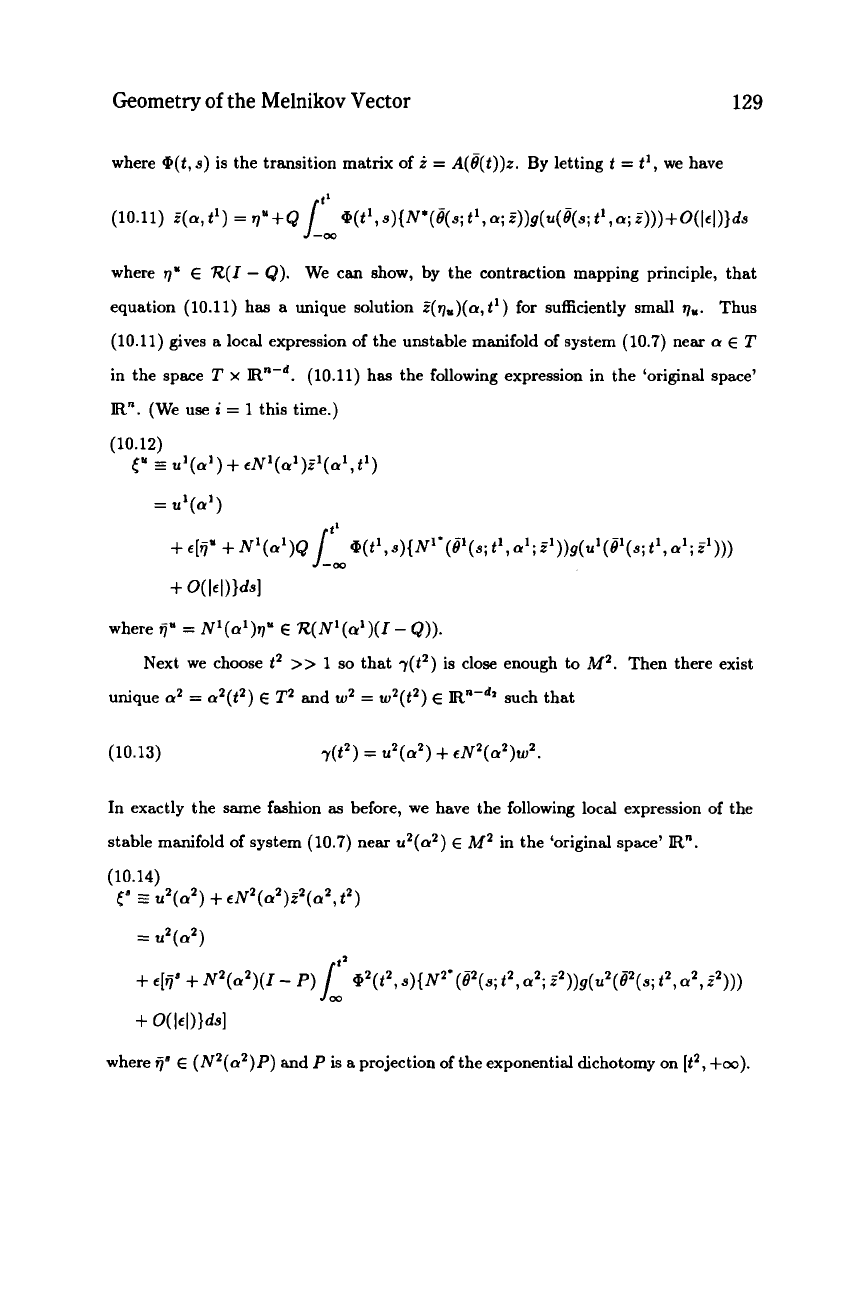
Geometry
of
the
Melnikov
Vector
129
where
O(t,
s)
is the transition matrix of
i
=
A(#(t))r.
By letting
t
=
t',
we have
(10.1 1)
f(
a,
t')
=
qu
+
Q
I"
@(t',
s){N*(#(s;
t'
,
a;
f))g(u(
B(s;
t'
,
a;
Z)))+O(
1el))ds
J
-m
where
qy
E
'R(I
-
9).
We can show, by the contraction mapping principle, that
equation (10.11) has a unique solution
f(q,,)(a,t')
for sufficiently small
q,,.
Thus
(10.11) gives
a
local expression
of
the unstable manifold
of
system (10.7) near
a
E
T
in the space
T
x
R"-d.
(10.11) has the following expression in the 'original space'
R".
(We use
i
=
1
this time.)
(10.12)
ly
=
.'(a')
+
cN'(a')Z'(a1,tl)
=
.'(a')
tl
+
e[fj'
+
N'(a'
)&
@(t',
s){N'*
(#'(s;
t'
,
a'
;
f'))g(u'(B'(s;
t',
a'
;
Z'
)))
J_m
+
O(lel))d4
where
fj"
=
N'(a')q'
E
R(N'(a')(I
-
Q)).
Next we choose
tZ
>>
1
so
that
r(t2)
is close enough to
MZ.
Then there exist
unique
a2
=
a'(@)
E
TZ
and
wz
=
w2(t2)
E
Rn--da
such that
(10.13)
r(t2)
=
.'(a')
+
eN2(aZ)wZ
In exactly the same fashion
as
before, we have the following local expression of the
stable manifold of system (10.7) near
.'(a')
E
MZ
in the 'original space'
R".
(10.14)
tn
EZ
u'(a2)
+
eN2(a2)2(aZ,t2)
=
.2(a2)
1)
+
+j"
+
NZ(aZ)(I-
P)J_
62(t2,s){N~.(e~(s;t2,a2;12))g(.2(B~(s;t~,a2,Z*)))
+
O(lel))dsI
where
4'
E
(N2(a2)P)
and
P
is a projection of the exponential dichotomy on
[t',
+w).
